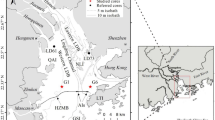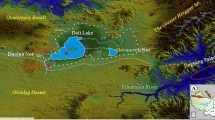Abstract
Grain size of lake sediments is often measured in paleolimnological studies, especially investigations of past lake-level changes. The paleohydrologic implications of such measures, however, remain unclear. We explored the relationship between grain-size characteristics of surface sediments in Selin Co, central Tibet (Median Diameter (Md), fine component percentage, and the grain-size frequency distribution curve), and both water depth and offshore distance. Under the same river/runoff transport and wind conditions, the Md value of grain size displays a significant negative correlation with water depth (r = − 0.767, N = 22, P < 0.001) and offshore distance (r = − 0.633, N = 22, P = 0.002), whereas the percentage of grains < 10 μm has a significant positive correlation with water depth (r = 0.689, N = 22, P < 0.001) and offshore distance (r = 0.673, N = 22, P < 0.001). The percentage of grains < 4 μm was also positively correlated with water depth and offshore distance (r = 0.549, N = 22, P < 0.01 for both). We recommend that the grain sizes transported by river/runoff or wind be identified and eliminated from consideration before employing the Md value and < 10-μm component of grain size for lake level reconstruction. The modal size of ~ 10 μm in the grain-size distribution curve is not affected by river/runoff or wind transportation, and is a reliable proxy for past lake level reconstruction, with smaller modal sizes associated with larger offshore distance [r = − 0.577, N = 22, P = 0.006), larger lake area (r = − 0.786, N = 7, P = 0.036) and higher annual precipitation (r = − 0.784, N = 8, P = 0.021 for Bange (station 55279) and r = − 0.769, N = 8, P = 0.026 for Shenzha (station 55472)].
Similar content being viewed by others
References
An FY, Ma HZ, Wei HC, Lai ZP (2012) Distinguishing aeolian signature from lacustrine sediments of the Qaidam Basin in northeastern Qinghai–Tibetan Plateau and its palaeoclimatic implications. Aeolian Res 4:17–30
Bennett SJ, Best JL (1995) Mean flow and turbulence structure over fixed, two dimensional dunes: implications for sediment transport and bedform stability. Sedimentology 42:491–513
Dasang (2011) The trends of air temperature and precipitation changes in the past 50 years in Selincuo Lake area, Tibet. Sci Technol Tibet 1:42–45 (in Chinese)
Friedman GM, Sanders JE (1978) Principles of sedimentology. Wiley, New York, p 792
Graham EJ, Rea DK (1980) Grain size and mineralogy of sediment cores from western Lake Huron. J Great Lakes Res 6:129–140
Håkanson L, Jansson M (1983) Principles of lake sedimentology. Springer, Berlin, p 316
Jiang QF, Shen J, Liu XQ, Ji JF (2010) Environmental changes recorded by lake sediments from Lake Jili, Xinjiang during the past 2500 years. J Lake Sci 22:119–126 (in Chinese, English abstract)
Kashiwaya K, Yamamoto A, Fukuyama K (1987) Time variations of erosional force and grain size in Pleistocene lake sediments. Quat Res 28:61–68
Kranck K, Smith PC, Milligan TG (1996) Grain-size characteristics of fine-grained unflocculated sediments II: ‘multi-round’ distributions. Sedimentology 43:597–606
Laba Chen T, Labazhuoma Cizhen (2011) Area change of Selincuo Lake and its forming reasons based on MODIS data. J Meteorol Environ 27:69–72 (in Chinese, English abstract)
Liu XQ, Wang SM, Shen J (2003) The grainsize of the core QH-2000 in Qinghai Lake and its implication for paleoclimate and paleoenvironment. J Lake Sci 15:112–117 (in Chinese, English abstract)
Lv P, Qu YG, Li WQ, Wang HS (2003) Shelincuo and Bangecuo extensional lake basins in the northern part of Tibet and present chasmic activities. Jilin Geol 22:15–19 (in Chinese, English abstract)
McCave IN (1978) Grain size trends and transport along beaches: an example from eastern England. Mar Geol 28:43–51
Påsse T (1997) Grain size distribution expressed as tanh-functions. Sedimentology 44:1011–1014
Peng YJ, Xiao JL, Nakamura T, Liu BL, Inouchi Y (2005) Holocene East Asian monsoonal precipitation pattern revealed by grain-size distribution of core sediments of Daihai Lake in Inner Mongolia of north-central China. Earth Planet Sci Lett 233:467–479
Poizot E, Mear Y, Thomas M, Garnaud S (2006) The application of geostatistics in defining the characteristic distance for grain size trend analysis. Comput Geosci 32:360–370
Self RP (1977) Longshore variation in beach sands, Nautla area, Veracruz, Mexico. J Sediment Petrol 47:1437–1443
Shen HY, Li SJ, Yu SB, Yao SC (2007) Grain-size characteristics of sediments from the Zigetang Co Lake, Tibetan Plateau and their environmental implication. Quat Sci 27:613–619 (in Chinese, English abstract)
Sly PG (1978) Sedimentary processes in lakes. In: Lerman A (ed) Lakes: chemistry, geology, physics. Springer, Berlin, pp 65–89
Sun QL, Zhou J, Xiao JL (2001) Grain-size characteristics of Lake Daihai sediments and its paleaoenvironment significance. Mar Geol Quat Geol 21:93–95 (in Chinese, English abstract)
Sun DH, Bloemendal J, Rea DK, Vandenberghe J, Jiang FC, An ZS, Su RX (2002) Grain-size distribution function of polymodal sediments in hydraulic and aeolian environments, and numerical partitioning of the sedimentary components. Sediment Geol 152:263–277
Tsoar H, Pye K (1987) Dust transport and the question of desert loess formation. Sedimentology 34:139–153
Visher GS (1969) Grain size distributions and depositional processes. J Sediment Petrol 39:1074–1106
Wang HL, Zheng MP (2014) Lake level changes indicated by grain-size of Core SL-1 sediments since 5.33 ka BP in Selin Co, central Qinghai–Tibetan Plateau. Sci Technol Rev 32:29–34
Wang SM, Yu YS, Wu RJ, Feng M (1990) The Daihai Lake: environment evolution and climate change. University of Science and Technology of China Press, Hefei, p 191 (in Chinese)
Wang SM, Dou HS, Chen KZ, Wang XC, Jiang JH (1998) China lakes record. Sci Press, Beijing, p 399 (in Chinese)
Wang HL, Zheng MP, Yuan HR (2016) Highstands in the interior of the Qinghai–Tibetan Plateau since the last interglacial: evidence from grain-size analysis of lacustrine core sediments in Zabuye Salt Lake. Geol J 51:737–747
Xiao JL, Fan JW, Zhou L, Zhai DY, Wen RL, Qin XG (2013) A model for linking grain-size component to lake level status of a modern clastic lake. J Asian Earth Sci 69:149–158
Xu SJ, Wang T (2011) Comparative study on the grain size characteristics of loess deposit both on Miaodao Islands and on the Laizhou Bay plain and its implications for provenance. Procedia Environ Sci 10:1869–1875
Yin ZQ, Qin XG, Wu JS, Ning B (2008) Multimodal grain-size distribution characteristics and formation mechanism of lake sediments. Quat Sci 28:345–353 (in Chinese, English abstract)
Zhuo G, Yang XH, Tang H (2007) Effects of climate change on lake acreage in Naqu region. Plateau Meteorol 26:485–490 (in Chinese, English abstract)
Acknowledgements
This study was supported by the Fundamental Research Funds for Central Leveled Scientific Research Institutes (JYYWF20182701), the National Natural Science Foundation of China (41372179) and China Geological Survey (DD20160054). Professor Peter Hudson from South Australian Museum, Adelaide, kindly improved the English.
Author information
Authors and Affiliations
Corresponding author
Electronic supplementary material
Below is the link to the electronic supplementary material.
Rights and permissions
About this article
Cite this article
Wang, C., Wang, H., Song, G. et al. Grain size of surface sediments in Selin Co (central Tibet) linked to water depth and offshore distance. J Paleolimnol 61, 217–229 (2019). https://doi.org/10.1007/s10933-018-0054-8
Received:
Accepted:
Published:
Issue Date:
DOI: https://doi.org/10.1007/s10933-018-0054-8















